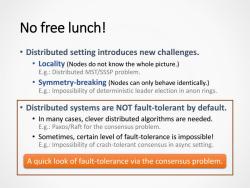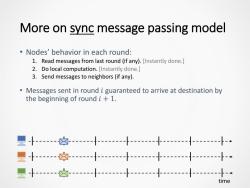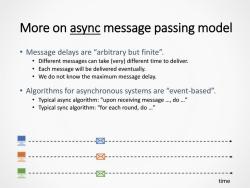南京大学:《计算理论之美》课程教学资源(课件讲稿)Distributed Consensus Reaching Agreement in Faulty Environment

Distributed Consensus Reaching Agreement in Faulty Environment 郑朝栋 南京大学计算机科学与技术系
Distributed Consensus Reaching Agreement in Faulty Environment 郑朝栋 南京大学计算机科学与技术系

Distributed computing is everywhere! ☆ What is distributed computing? Multiple agents cooperate to accomplish a task f(P1,P2,P3,…,Pn)→Y
Distributed computing is everywhere! Multiple agents cooperate to accomplish a task 𝑓 𝑃1, 𝑃2, 𝑃3, ⋯ , 𝑃𝑛 → 𝑌 What is distributed computing?

Why we love distributed computing? 。Better performance 2020天猫双全球狂入 RYZEN hedoop 双111 交额49822 210为下hc 1406个4 Stronger fault-tolerance …fel DDos
Why we love distributed computing? • Better performance • Stronger fault-tolerance

No free lunch! Distributed setting introduces new challenges. Locality (Nodes do not know the whole picture.) E.g.:Distributed MST/SSSP problem. Symmetry-breaking(Nodes can only behave identically.) E.g.:Impossibility of deterministic leader election in anon rings. Distributed systems are NOT fault-tolerant by default. In many cases,clever distributed algorithms are needed. E.g.:Paxos/Raft for the consensus problem. Sometimes,certain level of fault-tolerance is impossible! E.g.:Impossibility of crash-tolerant consensus in async setting. A quick look of fault-tolerance via the consensus problem
No free lunch! • Distributed setting introduces new challenges. • Locality (Nodes do not know the whole picture.) E.g.: Distributed MST/SSSP problem. • Symmetry-breaking (Nodes can only behave identically.) E.g.: Impossibility of deterministic leader election in anon rings. • Distributed systems are NOT fault-tolerant by default. • In many cases, clever distributed algorithms are needed. E.g.: Paxos/Raft for the consensus problem. • Sometimes, certain level of fault-tolerance is impossible! E.g.: Impossibility of crash-tolerant consensus in async setting. A quick look of fault-tolerance via the consensus problem

10110 Model and Problem
Model and Problem

Modeling distributed systems: Shared Memory and Message Passing RAM RAM RAM M RAM RAM RAM RAM RAM 1 Shared memory: Message passing: Processors exchange information Nodes exchange information via via read/write shared registers. send/receive messages to/from neighbours
Modeling distributed systems: Shared Memory and Message Passing Shared memory: Processors exchange information via read/write shared registers. Message passing: Nodes exchange information via send/receive messages to/from neighbours

More on the message passing model Model the system as a graph Each node is a processor. Each edge is a bidirectional communication link. ·Synchronous systems Time proceeds in synchronous rounds. Each round lasts a fixed duration (e.g.,1 second). Nodes agree on beginning/ending of each round. one round ----十--- im
More on the message passing model • Model the system as a graph • Each node is a processor. • Each edge is a bidirectional communication link. • Synchronous systems • Time proceeds in synchronous rounds. • Each round lasts a fixed duration (e.g., 1 second). • Nodes agree on beginning/ending of each round. time one round

More on sync message passing model Nodes'behavior in each round: 1.Read messages from last round (if any).[Instantly done.] 2.Do local computation.[Instantly done.] 3.Send messages to neighbors (if any). Messages sent in round i guaranteed to arrive at destination by the beginning of round i+1. 里☆小十l 2{-☒----- 里☆-十--- time
More on sync message passing model • Nodes’ behavior in each round: 1. Read messages from last round (if any). [Instantly done.] 2. Do local computation. [Instantly done.] 3. Send messages to neighbors (if any). • Messages sent in round 𝑖 guaranteed to arrive at destination by the beginning of round 𝑖 + 1. time

More on async message passing model 。Message delays are“arbitrary but finite", Different messages can take(very)different time to deliver. Each message will be delivered eventually. We do not know the maximum message delay. Algorithms for asynchronous systems are "event-based". Typical async algorithm:"upon receiving message...,do..." Typical sync algorithm:"for each round,do..." ☒ ☒ ☒ time
More on async message passing model • Message delays are “arbitrary but finite”. • Different messages can take (very) different time to deliver. • Each message will be delivered eventually. • We do not know the maximum message delay. • Algorithms for asynchronous systems are “event-based”. • Typical async algorithm: “upon receiving message …, do …” • Typical sync algorithm: “for each round, do …” time

Complexity measure Time complexity:number of rounds needed to accomplish the task in the worst case.(How about async systems?) Message complexity:number of messages/bits needed to transmit to accomplish the task in the worst case. Space complexity:size of local/total memory needed to accomplish the task in the worst case. Feasibility:can the given task be accomplished at all
Complexity measure • Time complexity: number of rounds needed to accomplish the task in the worst case. (How about async systems?) • Message complexity: number of messages/bits needed to transmit to accomplish the task in the worst case. • Space complexity: size of local/total memory needed to accomplish the task in the worst case. • Feasibility: can the given task be accomplished at all
按次数下载不扣除下载券;
注册用户24小时内重复下载只扣除一次;
顺序:VIP每日次数-->可用次数-->下载券;
- 南京大学:《计算理论之美》课程教学资源(课件讲稿)Color Coding.pdf
- 南京大学:《计算理论之美》课程教学资源(课件讲稿)Cluster expansion lemma.pdf
- 同济大学:《大学计算机基础》课程教学资源(教案讲义)Operating system 2.ppt
- 同济大学:《大学计算机基础》课程教学资源(教案讲义)Operating system 1.ppt
- 同济大学:《大学计算机基础》课程教学资源(教案讲义)Fundamentals of Network 2.ppt
- 同济大学:《大学计算机基础》课程教学资源(教案讲义)Fundamentals of Network 1.ppt
- 同济大学:《大学计算机基础》课程教学资源(教案讲义)Basics of Multimedia 2.ppt
- 同济大学:《大学计算机基础》课程教学资源(教案讲义)Mail Merge.ppt
- 同济大学:《大学计算机基础》课程教学资源(教案讲义)Basics of Multimedia 1.ppt
- 同济大学:《大学计算机基础》课程教学资源(教案讲义)Fundamentals of Computers Introduction(负责人:臧笛).ppt
- 同济大学:《大学计算机基础》课程教学资源(教案讲义)Microsoft Excel.ppt
- 同济大学:《大学计算机基础》课程教学资源(教案讲义)Database.ppt
- 同济大学:《大学计算机基础》课程教学资源(教案讲义)Basics of Computer System.ppt
- 同济大学:《大学计算机基础》课程教学资源(教案讲义)Data Representation.ppt
- 同济大学:《大学计算机基础》课程教学资源(试卷习题)试卷样本及答案.doc
- The Not So Short Introduction to LaTeX2ε(Or LATEX 2ε in 139 minutes).pdf
- 上饶师范学院:《数据库系统原理》课程教学资源(PPT课件)数据库系统概论 An Introducation to Database System(完整版).ppt
- 上饶师范学院:《数据库系统原理》课程教学资源(电子教案)数据库系统原理电子教案(共九章).doc
- 上饶师范学院:《数据库系统原理》课程教学资源(资料讲义)数据库系统原理实验讲义(上机实验讲义).doc
- 上饶师范学院:《数据库系统原理》课程教学资源(试卷习题)数据库系统原理习题集及答案.doc
- 南京大学:《计算理论之美》课程教学资源(课件讲稿)Principles of Quantum Computation.pptx
- 南京大学:《计算理论之美》课程教学资源(课件讲稿)Some efficient algorithms for the k-vertex cover problem.pdf
- 南京大学:《计算理论之美》课程教学资源(课件讲稿)Lovász Local Lemma(LLL).pdf
- 南京大学:《计算理论之美》课程教学资源(课件讲稿)Perfect Sampling for(Atomic)Lovász Local Lemma.pptx
- 南京大学:《计算理论之美》课程教学资源(课件讲稿)An introduction to quantum error-correction.pdf
- 南京大学:《计算理论之美》课程教学资源(课件讲稿)Lovász local lemma(Shearer).pdf
- 南京大学:《计算理论之美》课程教学资源(课件讲稿)Social Choice Theory.pdf
- 《数据库设计与应用》课程教学资源(PPT课件讲稿)T-SQL语言.pdf
- 《Python程序开发》教学资源(讲义)第二章 数据类型与结构.pdf
- 《C语言程序设计》课程教学资源(教案讲义)第8章 函数.pdf
- 《单片机应用技术》课程教学资源(教案)单片机应用技术教案.pdf
- 《Artificial Intelligence:A Modern Approach》教学资源(教材,英文版)Part II Problem Solving 5 Constraint Satisfaction Problems.pdf
- 《Artificial Intelligence:A Modern Approach》教学资源(教材,英文版)Part III Knowledge and Reasoning 7 Logical Agents.pdf
- 《Artificial Intelligence:A Modern Approach》教学资源(教材,英文版)Part IV Planning 11 Planning.pdf
- 《Artificial Intelligence:A Modern Approach》教学资源(教材,英文版)Part VI Learning 20 Statistical Learning Methods.pdf
- 《Artificial Intelligence:A Modern Approach》教学资源(讲义,英文版)chapter01-6pp.pdf
- 《Artificial Intelligence:A Modern Approach》教学资源(讲义,英文版)chapter01.pdf
- 《Artificial Intelligence:A Modern Approach》教学资源(讲义,英文版)chapter02-6pp.pdf
- 《Artificial Intelligence:A Modern Approach》教学资源(讲义,英文版)chapter02.pdf
- 《Artificial Intelligence:A Modern Approach》教学资源(讲义,英文版)chapter03-6pp.pdf
